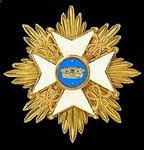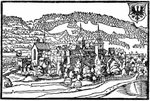First raised in Germany as Furstemberg in 1668 then joined the French army in 1670 as a foreign regiment. Name changes included Sparre, Greder and then Saxe 1720 to 1750 before becoming Bentheim. Two battalions in the SYW and ranked as number 46.
I take the design of the outer border and stripes from the 1721 French MS (which shows the flags when the regiment was still called Sparre with the same design as later but in different colours) and from the 1757 MS. This differs from the way the design is often depicted but I think those two sources are likely to offer a more authentic version of the design.
The regiment was very active in the Franco-Dutch War of 1672-8, the Nine Years' War 1688-97, the War of the Spanish Succession 1701-13 including the battles of Blenheim, Oudenarde and Malplaquet, the War of the Polish Succession 1733-35 and also the War of the Austrian Succession 1740-48, where much of its work involved sieges and the capture of various towns.
Susane Vol.6 on Bentheim in the Seven Years' War (my translation):
In October 1756 the regiment, now called Bentheim, was destined to take part in the relief efforts which the king intended to send to the Empress [Maria Theresa] but the order was never given and Bentheim became part of the Army of the Lower Rhine in 1757. It did not take part in any prominent action during the first two campaigns of the Seven Years' War. One finds it in 1758 in garrison at Gottingen and later at Drantzfeld.
In 1759 it belonged to a colonel who probably cared more than his predecessor about the reputation of his regiment; for one finds it, on the 13th April, at the battle of Bergen where Captain de Nardin was killed. On the 1st August, it fought with honour at the battle of Minden, where it was on the extreme right wing with regiments Auvergne and Aquitaine. But it was distinguished above all, on the 8th, during the retreat through the gorges of Munden, at the combat of Eimbeck. Colonel-commandant de Courvoisier, aide-major Freytag, captains de Vanaltz and Culmann, and four lieutenants were wounded there.
On the 18th of January 1760 the regiment of Anhalt [formerly Bentheim] was increased to three battalions by the incorporation of the first battalion of the regiment of Lowendhal. It fought with spirit on the 10th July at Corbach; but on the 16th it allowed itself to be surprised by the Hereditary Prince of Brunswick and part of the regiment was made prisoner of war. The Prince of Anhalt, surrounded by the British, was going to perish and owed his salvation only to a soldier of Royal-Bavière who deflected the blow aimed at him. The Prince became a prisoner. His regiment remained as a garrison unit for the following two campaigns and was reduced to two battalions by the Ordonnance of 21st December 1762.
At the moment peace was declared Anhalt was in garrison at Metz.
And this was the uniform in 1756:



















